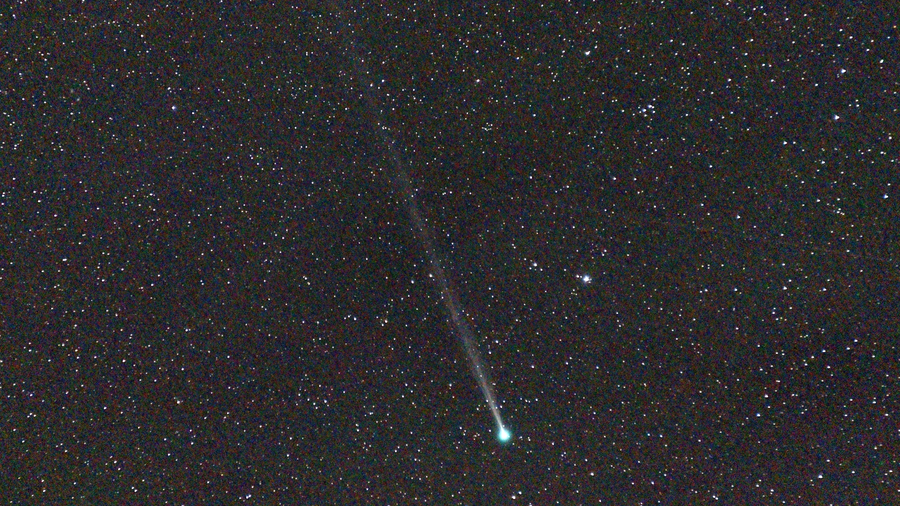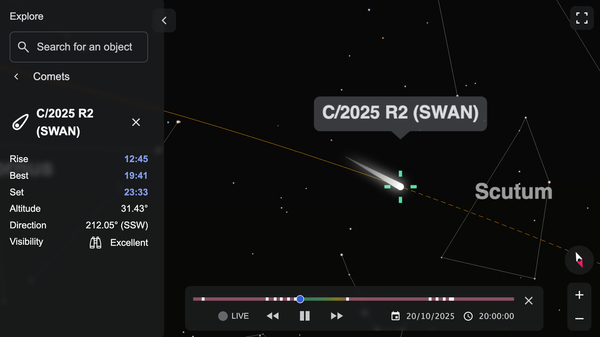
A report dated November 2 from the Teide Observatory in the Canary Islands suggests that C/2025 R2 (SWAN) may have split into two pieces. However, this is still to be confirmed.
A Faint Naked-Eye Comet?
Skywatchers might catch a glimpse of C/2025 R2 (SWAN) during October 2025. The comet is expected to have a magnitude (brightness) of around 6.0 for most of the month (although comets are famously unpredictable).
This means it might just be visible with the naked eye. But this would require good dark-sky conditions, well away from city lights or other sources of light pollution—and fuzzy comets can be harder to spot than twinkling, point-like stars. Alternatively, the comet should be visible with a pair of handheld binoculars.
On October 20, C/2025 R2 (SWAN) will pass within around 39 million kilometers (24 million miles) of Earth—about the same distance as Venus when it’s at its closest to Earth.
How to Spot C/2025 R2 (SWAN)
The comet may be visible above the southwestern or western horizon after the Sun sets and the sky darkens.
You can use our Night Sky Map to find C/2025 R2 (SWAN) from your town or city.
Click the calendar to select the date, and drag the marker back and forth along the timeline to see how the comet rises during the bright daytime sky, and sets during the night. Use the plus and minus buttons to zoom in and out.One tip for spotting the comet: Around October 13, it will pass close to Sabik, a bright star in the constellation Ophiuchus. Click here to see the positions of C/2025 R2 (SWAN) and Sabik on this date, as viewed from New York.

C/2025 R2 (SWAN) Facts & Figures
| Discovery | 11 Sep 2025 |
|---|---|
| Discovered by | SWAN / Vladimir Bezugly |
| Perihelion | 12 Sep 2025 |
| Closest approach to Earth | 20 Oct 2025 |
| Brightest magnitude | 6.0 (estimate) |
Frequently Asked Questions
What is a comet?
Comets are dusty, icy, rocky objects—often around one to ten kilometers in size—that orbit the Sun.
Read more about comets
What is magnitude?
The brightness of an astronomical object as seen from Earth is called its apparent magnitude. Two important things to know:
-
Magnitude uses a reverse scale: The lower the number, the brighter the object—in the case of very bright objects, the number can go below zero
-
Magnitude uses a logarithmic scale: If the magnitude of an object decreases by 1, it becomes about 2.512 times brighter
So although it may seem as though the Sun (magnitude -27) is only twice as bright as the Full Moon (magnitude -13), it is in fact 400,000 times brighter. (The difference between -27 and -13 is 14, and 2.512 multiplied by itself 14 times is 2.512^14, which is roughly 400,000.)
Below are some approximate examples of the average magnitude of objects as seen from Earth.
-
The Sun: -27
-
Full Moon: -13
-
Venus: -4.1
-
Jupiter: -2.2
-
Sirius (the brightest star): -1.5
-
Polaris (the Pole Star): +2.0
-
Limit of naked eye (with good conditions): +6.5
-
Neptune: +7.8
-
Limit of handheld binoculars: +9.5
What is perihelion?
Perihelion is the point where a comet—or other astronomical body—is at its closest to the Sun.
Perihelion and aphelion
What are the rules for comet names?
Those complicated-looking names are based on a set of rules from the International Astronomical Union. Let’s take C/2024 G3 (ATLAS) as an example:
-
C/ refers to a non-periodic comet. This means the comet hasn’t been observed before, and its orbital period (the amount of time it takes to complete one orbit around the Sun) is greater than 200 years
-
2024 is the year the comet was discovered
-
G indicates the half-month it was discovered—in this case, the first half of April. The first half of January is “A,” the second half of January is “B,” the first half of February is “C,” and so on. The letter “I” is skipped to avoid confusion with the number “1”
-
3 means it was the third comet discovered in that half-month
-
ATLAS is the name of the instrument that made the discovery—in this case, ATLAS is a system of robotic telescopes. Comets can also be named after people: for example, C/2024 E1 (Wierzchos) was discovered by the Polish astronomer Kacper Wierzchoś